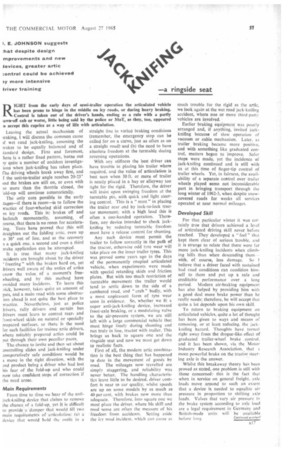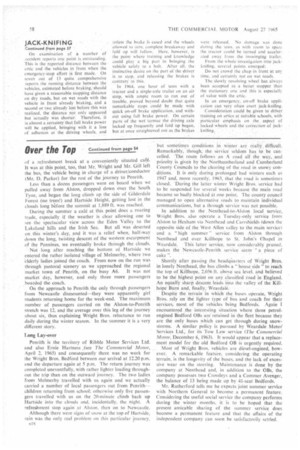I. E. JOHNSON suggests hat despite design mprovements and new ievices, greater artic :ontrol could be achieved ay more intensive
Page 59

Page 60

If you've noticed an error in this article please click here to report it so we can fix it.
iriver training
—a ringside seat
RIGHT from the early days of semi-trailer operation the articulated vehicle has been prone to hinge in the middle on icy roads, or during heavy braking. Control is taken out of the driver's bands, ending as a rule with a partly awn-off cab or worse, little being said by the police or MoT, as they, too, appeared
o accept this caprice as a way of life with articulation.
Leaving the actual mechanism of waking, [will discuss the common cause )f wet road jack-knifing, assuming the wakes to be equally balanced and of tandard design. First and foremost, here is a rather fixed pattern, borne out )y quite a number of accident investigaions when jack-knifing has taken place. Ile driving wheels break away first, and f the unit-to-trailer angle reaches 20-25' tnd the brakes are still on, or even with to more than the throttle closed, the 'old-up will continue automatically.
The only cure possible in the early ,tages—if there is room—is to follow the nactice of four-wheeled skid correction in icy roads. This is: brakes off and leclutch momentarily, assuming, of murse, that there is no room for acceleraing. Tests have proved that this will itraighten out the folding artic. even up
o 30' out of line, and as the recovery s a quick one, a second and even a third 3rake application can be attempted.
It is true that many jack-knifing ncidents are brought about by the driver 'freezing" with the brakes hard art, yet !rivers well aware of the antics of artics now the value of a moment's freevheeling, and by this method have !voided many incidents. To learn this rick, however, takes quite an amount of zuts, and a main road with some obstrucion ahead is not quite the best place to aractice. Nevertheless, just as police !rivers, rally drivers and certain bus !rivers must learn to control rearand 7ront-wheel skids on natural or specially areparcd surfaces, so there is the need or such facilities for trainee artic drivers, where suitably prepared artics could be aut through their own peculiar paces.
The chance to invite and then set about zontrolling slides and jack-knifing under :omparatively safe conditions would be s move in the right direction, with the .tnd product being a driver who had lost Ms fear of the fold-up and who could low take confident steps of correction if the need arose.
Main Requirements
From time to time we hear of the antilack-knifing device that claims to remove the chance. of a fold-up, yet it is difficult to provide -a damper that would .fiII two main requirethents of articulation: (a) a" device that would hold the outfit in a
straight line in varied braking conditions (remember, the emergency stop can be called for on a curve, just as often as on a straight road) and (b) the need to have absolute freedom at the turntable during reversing operations.
With any stiffness the best driver can have trouble in placing his trailer where required, and the value of articulation is best seen when 30 ft. or more of trailer is neatly placed in a bay or alleyway too tight for the rigid. Therefore, the driver will insist upon swinging freedom at the turntable pin, with quick and light steering control. This is a " must " in placing the trailer rear end by lock-to-lock tractor movement: with a high load this is often a one-handed operation. Therefore, any device intended to check jackknifing by reducing turntable freedom must have a release control for shunting.
Any such device must permit the trader to follow correctly in the path of the tractor, otherwise odd tyre wear will take place on the inner trailer tyres. This was proved some years ago in the days of the permanently coupled articulated 'vehicle, when experiments were made with special retarding skids and friction plates. But with too much restriction of turntable movement the trailer would tend to settle down to the side of a cambered road, and " crab " badly, with a most unpleasant form of tyre wear soon in evidence. So, whether we fit a super anti-jack-knifing device, increased front-axle braking, or a modulating valve to the air-pressure system, we are still left with a large commercial vehicle that must hinge freely during shunting and run truly in line, tractor with trailer. This brings us back to square one and the ringside seat and now we must get down to realistic facts.
First of all, the modern artic combination is the best thing that has happened to date in the movement of goods by road. The mileages now travelled are simply staggering, and reliability was never better. The handling characteristics leave little to be desired, driver comfort is near to car quality, whilst speeds are up on some models by as much as 40 per cent, with brakes now more than adequate. Therefore, into square one we must place the driver, where his skin and road sense arc often the measure of his freedom from accidents. Setting aside the icy road incident, which can cause as much trouble for the rigid as the mak. we look again at the wet road jack-knifing accident, where one or more third-party vehicles are involved.•
Earlier braking equipment was poorly arranged and, if anything, invited jackknifing because of slow operation of vacuum or cable mechanism. Later, as trailer braking became more positive, and with something like graduated control, matters began to improve. Safer stops were made, yet the incidence of jack-knifing continued and is still with us at this time of finger-tip control of trailer wheels. Yet, in fairness, the availability of a separate control over trailer wheels played some not inconsiderable part in bringing transport through the long winter of 1962-3, when despite snowcovered roads for weeks all services operated at near normal mileages.
Developed Skill For that particular winter it was certainly true that drivers achieved a level of articulated driving skill never before reached. They developed a "feel " that kept them clear of serious trouble, and it is strange to relate that there were far more jack-knifing incidents when climbing hills than when descending them — with, of course, less damage, So I believe that a driver faced with sustained bad road conditions can condition himself to them and put up a safe and creditable performance over a long period. Modern air-braking equipment has also helped by providing him with a good deal more brake power than he really needs: therefore, he will accept that quite a lot depends upon his own skill.
To return to braking equipment on articulated vehicles, quite a lot of thought has been given to ways and means of removing, or at least reducing. the jackknifing hazard. Thoughts have turned right away from the drogue-like.effect of graduated trailer-wheel brake .control. and it has been shown, via the Motor Industry Research Association., that t more powerful brake on the tractor steering axle is the answer.
Whilst this breakaway theory has been proved as stated, one problem is still with those concerned: this is the fact that when in service on general freight. axle loads move around to such an extent that a device is needed to equalize air pressure in proportion to shifting axle loads. Valves that vary air pressure in the brake system according to axle load are a legal requirement in Germany and British-made units will be available before Ione. Continued wetter:1r On examination of a number of accident reports one point is outstanding. This is the reported distance between the artic and the vehieles in front when the emergency-Stop effort is first made. On seven out of 13 quite comprehensive reports the running distance between the vehicles, estimated before braking; should have given a reasonable stopping distance on dry roads, but on wet roads with the vehicle in front already braking, and .a second or twc already lost before this was realized. the distance not only appeared but actually was shorter. Therefore, it is almost a certainty that full brake power will be applied, bringing with it a loss of adhesion at the driving wheels, and
unless the brake is eased and the wheels allowed to turn. complete breakaway and fold up will follow. Here, however, is the point where training and knowledge could play a big part in bringing the vehicle safely to a halt. After all, the instinctive desire on the part of the driver is to stop, and releasing the brakes is contrary to this.
In 1964, one hour of tests with a tractor and a single-axie trailer on an air strip, with ample room to run out of trouble, proved beyond doubt that quite remarkable stops could be made with quick on-off brake application, and without using full brake power. On certain parts of the wet. tarmac the driving axle locked up frequently and fold up began, but at once straightened out as the brakes
were released. No damage was done during the tests, as with room to spare the tractor could be turned and accelerated away from the inswinging trailer.
From the whole investigation into jackknifing, several points emerged: Do not crowd the chap in front at any time. and certainly not oil wet roads.
The, slowly revolving wheel has always been accepted as a better stopper than the stationary one and this is especially of value with the artic.
In an emergency, on-off brake application can very often avert jack-knifing.
Consideration could be given to driver training on anics at Suitable schools, with particular emphasis on the , aspect of locked wheels and the collection of jackknifing..












































































































